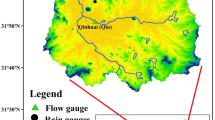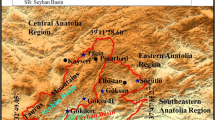Abstract
Drought is the result of altered hydrological conditions, in particular, due to precipitation deficit over a period of time, and is one of the most common disasters in all kinds of climate regimes (Chen et al. 2013). Unlike other natural disasters, the effects of drought appear gradually over time, typically on the order of several months to several years. Drought analysis usually involves estimating one of the drought indices and then calculating drought characteristics based on the determined drought index such as severity, duration, and peak intensity (Yang 2010). Among the methods for determining drought characteristics, the threshold value could provide a frame of reference for drought assessment (Yevjevich 1967). As climate change is expected to vary worldwide due to natural and model ambiguities, predicting the impact of climate change on future droughts is vital for water resources management. In the Northern Hemisphere—between 15° and 45° latitudes, including the current study area—drought periods have been particularly severe (Mousavi 2005).
Access this chapter
Tax calculation will be finalised at checkout
Purchases are for personal use only
Similar content being viewed by others
References
Chen YD, Zhang Q, Xiao M, Singh VP (2013) Evaluation of risk of hydrological droughts by the trivariate Plackett copula in the East River basin (China). Nat Hazards 68:529–547
Dastorani M, Bavani AM, Poormohammadi S, Rahimian M (2011) Assessment of potential climate change impacts on drought indicators (Case study: Yazd station Central Iran). Desert 16:159–167
Gohari A, Eslamian S, Abedi-Koupaei J, Bavani AM, Wang D, Madani K (2013) Climate change impacts on crop production in Iran’s Zayandeh Rud River Basin. Sci Total Environ 442:405–419
Golian S, Mazdiyasni O, AghaKouchak A (2015) Trends in meteorological and agricultural droughts in Iran. Theor Appl Climatol 119:679–688
Hoffman MT, Carrick P, Gillson L, West A (2009) Drought, climate change and vegetation response in the succulent karoo, South Africa. S Afr J Sci 105:54–60
Kirono D, Kent D, Hennessy K, Mpelasoka F (2011) Characteristics of Australian droughts under enhanced greenhouse conditions: results from 14 global climate models. J Arid Environ 75:566–575
Lee T, Modarres R, Ouarda T (2013) Data-based analysis of bivariate copula tail dependence for drought duration and severity. Hydrol Process 27:1454–1463
Li C, Singh VP, Mishra AK (2013) A bivariate mixed distribution with a heavy-tailed component and its application to single-site daily rainfall simulation. Water Resour Res 49:767–789. https://doi.org/10.1002/wrcr.20063
Madadgar S, Moradkhani H (2011) Drought analysis under climate change using copula. J Hydrol Eng 18:746–759
McKee TB, Doesken NJ, Kleist J (1993) The relationship of drought frequency and duration to time scales. In: Proceedings of the 8th conference on applied climatology, vol 22. American Meteorological Society, Boston, MA, pp 179–183
Moradi H, Rajabi M, Faragzadeh M (2011) Investigation of meteorological drought characteristics in Fars province, Iran. Catena 84:35–46
Mousavi S-F (2005) Agricultural drought management in Iran. In: Water conservation, reuse, and recycling: Proceedings of an Iranian-American Workshop. National Academies Press, pp 106–113
Nelsen RB (2007) An introduction to copulas. Springer Science & Business Media
Safavi HR, Esfahani MK, Zamani AR (2014) Integrated index for assessment of vulnerability to drought, case study: Zayandehrood River Basin, Iran. Water Resour Manag 28:1671–1688
Sayari N, Bannayan M, Alizadeh A, Farid A (2013) Using drought indices to assess climate change impacts on drought conditions in the northeast of Iran (case study: Kashafrood basin). Meteorol Appl 20:115–127
Selvaraju R, Baas S (2007) Climate variability and change: adaptation to drought in Bangladesh: a resource book and training guide, vol 9. Food and Agriculture Organisation, Rome
Serinaldi F, Bonaccorso B, Cancelliere A, Grimaldi S (2009) Probabilistic characterization of drought properties through copulas. Phys Chem Earth Parts A/B/C 34:596–605
Shiau J (2006) Fitting drought duration and severity with two-dimensional copulas. Water Resour Manag 20:795–815
Svoboda M, Hayes M, Wood DA (2012) Standardized precipitation index user guide, vol WMO 1090. World Meteorological Organization
Thom HCS (1966) Some methods of climatological analysis. Secretariat of the World Meteorological Organization, Geneva
Thrasher B, Xiong J, Wang W, Melton F, Michaelis A, Nemani R (2013) Downscaled climate projections suitable for resource management. EOS Trans Am Geophys Union 94:321–323
Wayne G (2013) The beginner’s guide to representative concentration pathways skeptical science
Xu K, Yang D, Xu X, Lei H (2015) Copula based drought frequency analysis considering the spatio-temporal variability in Southwest China. J Hydrol 527:630–640
Yan J (2007) Enjoy the joy of copulas: with a package copula. J Stat Softw 21:1–21
Yang W (2010) Drought analysis under climate change by application of drought indices and copulas
Yevjevich VM (1967) An objective approach to definitions and investigations of continental hydrologic droughts. Hydrology papers no 23. Colorado State University
Acknowledgments
With appreciation to the Iran Meteorological Organization for preparing the much-needed precipitation data. Also, the first author wishes to thank the Biological System and Engineering Department at Virginia Tech University for providing the opportunity of using its facilities and for the various consultations with the experts at Virginia Tech.
Author information
Authors and Affiliations
Editor information
Editors and Affiliations
Rights and permissions
Copyright information
© 2020 Springer Nature Switzerland AG
About this chapter
Cite this chapter
Motevali Bashi Naeini, E., Abedi Koupai, J., Akhoond-Ali, A.M. (2020). Returning Periods of Drought and Climate Change in the Zayandeh Rud River Basin. In: Mohajeri, S., Horlemann, L., Besalatpour, A.A., Raber, W. (eds) Standing up to Climate Change. Springer, Cham. https://doi.org/10.1007/978-3-030-50684-1_6
Download citation
DOI: https://doi.org/10.1007/978-3-030-50684-1_6
Published:
Publisher Name: Springer, Cham
Print ISBN: 978-3-030-50683-4
Online ISBN: 978-3-030-50684-1
eBook Packages: Biomedical and Life SciencesBiomedical and Life Sciences (R0)




